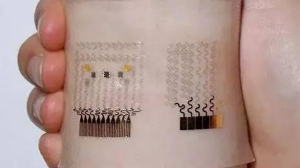In the current era of rapid development of artificial intelligence and biomedicine, flexible electronic skin that can simulate the sensing functions of human skin has become the focus of attention in the scientific research and industrial fields. This new type of electronic device not only has flexibility and stretchability, but can also accurately sense various physical quantities such as pressure, temperature, and humidity, and even simulate biological sensing functions such as touch and pain. From basic principles to key technologies, from diverse applications to future challenges, flexible electronic skin is reshaping the development pattern of human - machine interaction and intelligent devices in a disruptive manner.
Technical Principles and Core Architecture of Flexible Electronic Skin
Material Basis and Performance Characteristics
The core of flexible electronic skin lies in the application of special materials. Its substrate materials mostly use flexible polymer polymers such as polydimethylsiloxane (PDMS) and polyimide (PI). The elongation at break of these materials can reach 100% - 500%, which can meet different deformation requirements. The sensitive materials determine the sensing functions of the electronic skin. For example, piezoresistive materials based on carbon nanotubes and graphene have a significant change in resistance when subjected to pressure, and their piezoresistive coefficient can reach 10 - 100 kPa⁻¹, enabling precise detection of tiny pressures. Temperature - sensing materials based on flexible thermocouples can sense environmental temperature changes with an accuracy of 0.1℃.
Multilayer Composite Architecture Design
Typical flexible electronic skin adopts a multilayer composite structure, which from the inside out are the base layer, sensing layer, electrode layer, and protective layer. The base layer provides flexible support; the sensing layer integrates various sensitive materials and is responsible for sensing external physical quantity changes; the electrode layer is used to transmit electrical signals; the protective layer ensures the stability of the device in complex environments. The layers are precisely bonded through micro - nano processing technologies. For example, processes such as photolithography and inkjet printing can control the line width of the electrode pattern to less than 10 microns, ensuring the high - efficiency and stability of signal transmission.

Key Advantages of Flexible Electronic Skin
High Flexibility and Conformability
Unlike traditional rigid electronic devices, flexible electronic skin can closely adhere to curved surfaces, irregular surfaces, and even human skin. Its bending radius can be as low as 1 millimeter, and the tensile strain can exceed 300%. It will not cause a sense of restraint to the human body during wearing. This characteristic makes it highly valuable in the field of wearable devices, such as smart bracelets and health monitoring patches, which can collect human physiological data in real - time and comfortably.
Multimodal Sensing Ability
Flexible electronic skin can integrate a variety of sensors to achieve synchronous sensing of multiple physical quantities such as pressure, temperature, humidity, and strain. For example, a research team in South Korea developed a flexible electronic skin that integrates 100 pressure sensors and 50 temperature sensors within an area of 1 square centimeter. It can simultaneously obtain information on pressure distribution and temperature changes, playing an important role in scenarios such as robot tactile perception and virtual reality interaction.
Bionic and Intelligent Characteristics
By simulating the perception mechanism of human skin, flexible electronic skin can possess bionic functions such as touch and pain sensation. The electronic skin developed by Stanford University in the United States can sense different degrees of pressure stimulation and generate electrical signal feedback similar to human pain according to the stimulation intensity. This provides a new technical path for fields such as prosthetic tactile feedback and emotional interaction of intelligent robots.
Exploration of Diverse Application Scenarios
Medical and Health Field
In the medical field, flexible electronic skin can be used for disease diagnosis and health monitoring. Diabetic patients can wear an electronic skin patch integrated with a glucose sensor to monitor the glucose concentration in subcutaneous tissue fluid in real - time, with a monitoring accuracy of up to ±5 mg/dL, which is more convenient and painless compared to traditional fingertip blood sampling. In addition, electronic skin can also be used for rehabilitation treatment. By sensing muscle electrical signals and joint range of motion, it can provide personalized rehabilitation training programs for patients.
Robotics and Automation Field
For robots, flexible electronic skin endows them with a more realistic tactile perception ability. After the Atlas robot of Boston Dynamics is equipped with electronic skin, it can accurately sense the texture, shape, and gripping force of objects, increasing the success rate of handling fragile items by 40%. On the industrial automation production line, electronic skin can be installed on the surface of the robotic arm, enabling it to sense the collision risk in a timely manner when collaborating with humans and automatically adjust its actions to ensure the safety of human - machine collaborative operations.
Virtual Reality and Augmented Reality
In the VR/AR field, flexible electronic skin brings an immersive tactile experience to users. When users wear gloves or clothing integrated with electronic skin and touch objects in a virtual environment, they can feel the corresponding pressure and texture feedback. For example, in virtual surgery training, doctors can truly sense the contact force between surgical instruments and tissues through electronic skin, improving the training effect and surgical operation skills.
Smart Wearables and Consumer Electronics
After consumer electronics products such as smart watches and fitness clothes are equipped with electronic skin technology, their functions are further expanded. The smart bracelet launched by Huawei can, through the electronic skin sensor, monitor data such as the user's heart rate variability and skin electrical response in real - time, providing users with a more comprehensive health assessment report to meet consumers' needs for personalized health management.

